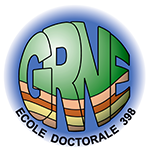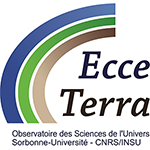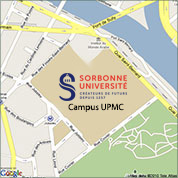Séminaire ISTeP - Vincent Strak
(Vrije Universiteit Amsterdam)
2-D thermo-mechanical numerical modelling of the South American subduction zone: effects of mantle depth extent, mantle rheology and slab thermal weakening
The South American subduction zone challenges our view of subduction dynamics and mountain building because it has enigmatically produced the Andes as a result of oceanic lithosphere subduction, thus the orogeny was not formed from the classical scenario of continental collision. It is also an intriguing subduction system with the widest along-trench dimension on Earth and subduction of aseismic ridges, two factors that likely impact on subduction dynamics and on the resulting surficial velocities and natural hazards. Building geodynamic models is thus important to improve our understanding of the complex South American subduction system. But before we build 3-D models with intricate rheologies, it is crucial to constrain independent model variables including mantle depth extent, upper- and lower-mantle rheology and slab thermal weakening using relatively simple 2-D numerical buoyancy-driven subduction models. As a means of constraining those model variables we propose to compare our model outcomes with the present-day upper- and lower-mantle slab geometry observed on tomography models. Tomography models indicate that the slab in the center of the South American subduction zone dips eastward in the whole mantle, but the dip angle changes with depth and a thick high density anomaly is observed in the lower mantle, suggesting some folding of the slab. Replicating this disctinct slab geometry using our geodynamic modelling allowed us to find a range of reasonable values that can be used for the independent variables in future modelling. We find for instance that using a large mantle depth extent (>2000 km) is crucial to reproduce the upper- and lower-mantle slab geometry. An additional objective of our geodynamic subduction models is to give insights into the effect(s) of the tested independent variables on the geodynamics and kinematics of generic subduction. Our results show that using a non-linear rheology for the upper mantle is more efficient to produce slab folding in the lower mantle and it accelerates the subducting plate velocity, while slab thermal weakening does not affect much slab geometry but increases subducting plate velocity.
21/06/2019, Salle Tethys (Tour 56/66, 3ème étage) à 12h30
Egalement dans la rubrique
- Séminaire ISTeP - Bellanger et Hermant
- Séminaire ISTeP - Guillaume Le Hir
- Séminaire ISTeP - Armel Menant
- Séminaire ISTeP - Nicolas Grasseau
- Séminaire ISTeP - Isabelle Moretti
- Séminaire ISTeP - Jean-Arthur Olive
- Séminaire ISTeP - Louise Jeandet
- Séminaire ISTeP - Hugues Raimbourg
- Séminaire ISTeP - Baptiste Rousset
- Séminaire ISTeP - Lucile Bruhat
- Séminaire ISTeP - Alfonso Mucci
- Séminaire ISTeP - Anthony Jourdon
- Séminaire ISTeP - Marianne Conin
- Séminaire ISTeP - David Pyle
Chiffres clés (Mars 2025)
L'ISTeP comprend 131 membres dont :
Permanents (66)
- Professeurs : 17 (+2 PAST)
- Maîtres de conférence : 26
- Directeurs de recherche CNRS : 1
- Chargés de recherche CNRS : 1
- ITA : 19
Personnels non permanents (65)
- Collaborateurs bénévoles / émérites : 17
- Chaire de professeur junior : 1
- Enseignants-chercheurs contractuel : 2
- 1 MCF accueil en délégation
- ATER et Post-Docs : 9
- Doctorants : 32
- ITA-BIATSS : 3





